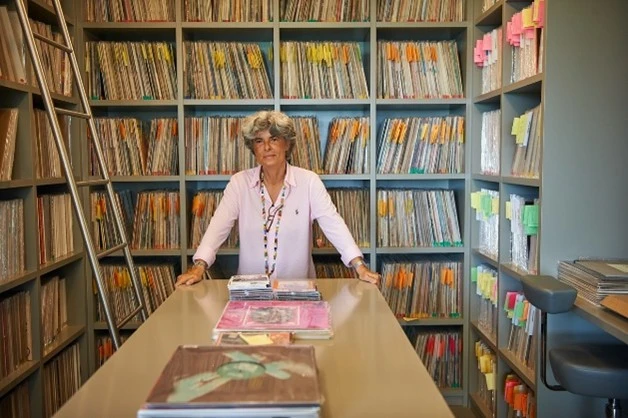
Alejandra Fierro Eleta, a promoter of the Gladys Palmera Foundation, 2023. Photograph: courtesy of the Gladys Palmera Foundation
To celebrate the twenty-fifth anniversary of Gladys Palmera, the Museo Reina Sofía organises, in collaboration with the Gladys Palmera Foundation, a day which spins around African-influenced dances and rhythms, for instance danzón, chachachá, mambo, rumba, cumbia, salsa and ballenato, genres which have shaped Latin American cultural identity, from the Caribbean islands to the Southern Cone,
Behind Gladys Palmera is Alejandra Fierro Eleta and her passion for preserving and disseminating the Afro-Latino music legacy. The Gladys Palmera Foundation project came into being twenty-five years ago with Radio Gladys Palmera, the first radio station in Spain to specialise in Latin and Caribbean music and which today still inspires and champions musical diversity in its different formats. In parallel to the radio project is the Gladys Palmera Collection, set up by Fierro Eleta, a major archive assembled in San Lorenzo del Escorial and comprising over 55,000 vinyl records and 25,000 CDs of Latin music past and present, in addition to a valuable collection of graphic art, posters, photographs, sheet music and magazines — a cultural legacy kept alive by the Gladys Palmera Foundation to enhance, restore, digitise and catalogue its holdings for consultation on the project’s website.
The event begins with a music-based conversation with curators from the Foundation, José Arteaga and Tommy Meini, and continues with a dance workshop by Cuban dancer Claudia Valdivia, culminating in a vinyl session and dancing, where records past and present will be played from the Collection.
Organised by
Museo Reina Sofía
Sponsor

Agenda
viernes 11 oct 2024 a las 18:00
25 Years of Gladys Palmera
— A music-based conversation with José Arteaga and Tommy Meini
The curators of the Gladys Palmera Collection, José Arteaga and Tommy Meini, embark on a sound journey through the arc of the project, which began in 1999 as the prime radio station in Spain specialising in Latin music — still the case today — placing the stress on its valuable and diverse cultural legacy.
viernes 11 oct 2024 a las 18:45
Dance Workshop in the Salón Gladys Palmera
— Dance workshop with Claudia Valdivia
This dance workshop led by Cuban dancer Claudia Valdivia sets forth a trip through the Afro-Latin rhythms that have sculpted the musical landscape from the early twentieth century to the present day. The first part of the activity, entitled Vintage (Danzón, Chachachá and Mambo) focuses on these genres, while the second Romantic Salsa, Cumbia and Salsa Brava is devoted to more contemporary sounds from the world of Latin music. The musical selection will be hand-picked by Tommy Meini and José Arteaga.
viernes 11 oct 2024 a las 20:30
Salón Gladys Palmera
— Vinyl session and dancing
In this vinyl session, the curators of the Gladys Palmera Collection set off on a journey of dancing and listening through the musical landscape of the Caribbean and its influence on other continents.
Participants
José Arteaga is a writer and journalist from Pasto (Colombia) who is based in Spain. He is an expert in preserving music archives and the history of Caribbean music, which is the subject of different books he has written. A part of Radio Gladys Palmera since it was founded, he has produced different programmes, among them La Hora Faniática, a documentary and testimonial review of the history of the New York label Fania Records. His work also encompasses the online edition of gladyspalmera.com and coordinating the Gladys Palmera Collection, as well as his publications, among them Cha-Cha-Cha: un baile y una época (2020) and Música con nombre propio (2022).
Tommy Meini is a music lover and researcher who studied Fine Arts at Luminy University (Marseille). Noteworthy is his work as an exhibition producer, a curator of the photography festival Rencontres de la Photographie d'Arles (Arles) and a specialist concert photographer. His fascination with music led him to study Music History in Santiago de Cuba, before joining Blue Moon Producciones in Barcelona, where he re-released Cuban sound archives and oversaw an editorial imprint. Since 2014, he has worked as a researcher and curator in the Gladys Palmera Collection.
Claudia Valdivia is a Cuban dancer who graduated from the Instituto Superior de Arte de La Habana and the Escuela Nacional del Ballet de Cuba. For over twenty years, she has been part of the illustrious dance company Lizt Alfonso Dance Cuba (LADC), where she has worked with instructors such Fernando Alonso and Lizt Alfonso, sharing the stage with figures such as Misty Copeland and creating different pieces for the company’s repertoire, and for the production Habana Fénix (2023). Further, she has performed on different stages worldwide and has directed international tours as a choreographer and dance and fusion dance instructor.
Más actividades

Oliver Laxe. HU/هُوَ. Dance as if no one were watching you
Tuesday, 16 December 2025 – 7pm
As a preamble to the opening of the exhibition HU/هُوَ. Dance as if no one were watching you, film-maker Oliver Laxe (Paris, 1982) engages in conversation with the show’s curators, Julia Morandeira and Chema González, touching on the working processes and visual references that articulate this site-specific project for the Museo Reina Sofía. The installation unveils a new programme in Space 1, devoted from this point on to projects by artists and film-makers who conduct investigations into the moving image, sound and other mediums in their exhibition forms.
Oliver Laxe’s film-making is situated in a resilient, cross-border territory, where the material and the political live side by side. In HU/هُوَ. Dance as if no one were watching you, this drift is sculpted into a search for the transcendency that arises between dancing bodies, sacred architectures and landscapes subjected to elemental and cosmological forces. As a result, this conversation seeks to explore the relationship the piece bears to the imagery of ancient monotheisms, the resonance of Persian Sufi literature and the role of abstraction as a resistance to literal meaning, as well as looking to analyse the possibilities of the image and the role of music — made here in collaboration with musician David Letellier, who also works under the pseudonym Kangding Ray — in this project.
These inaugural conversations, part of the main working strands of the Museo’s Public Programmes Area, aim to explore in greater depth the exhibition narratives of the shows organised by the Museo from the perspective of artists, curators and specialists.
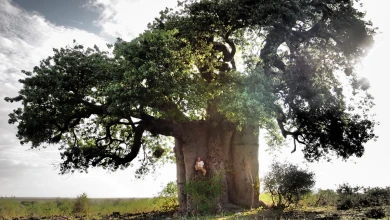
Francisco López and Barbara Ellison
Thursday, 11 December - 8pm
The third session in the series brings together two international reference points in sound art in one evening — two independent performances which converse through their proximity here. Barbara Ellison opens proceedings with a piece centred on the perceptively ambiguous and the ghostly, where voices, sounds and materials become spectral manifestations.
This is followed by Francisco López, an internationally renowned Spanish sound artist, who presents one of his radical immersions in deep listening, with his work an invitation to submerge oneself in sound matter as a transformative experience.
This double session sets forth an encounter between two artists who, from different perspectives, share the same search: to open ears to territories where sound becomes a poetic force and space of resistance.
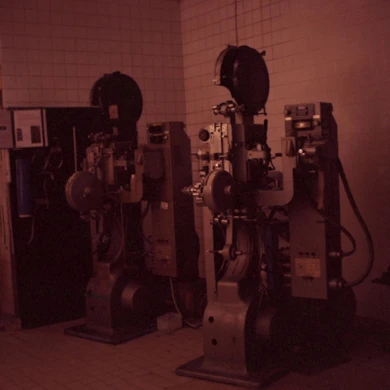
Long Live L’Abo! Celluloid and Activism
4, 5, 6 DIC 2025
L’Abominable is a collective film laboratory founded in La Courneuve (Paris, France) in 1996. It came into being in response to the disappearing infrastructures in artisan film-making and to provide artists and film-makers with a self-managed space from which to produce, develop and screen films in analogue formats such as Super 8, 16mm and 35mm. Anchored in this premise, the community promotes aesthetic and political experimentation in analogue film opposite digital hegemony. Over the years, L’Abominable, better known as L’Abo, has accompanied different generations of film-makers, upholding an international movement of independent film practices.
This third segment is structured in three sessions: a lecture on L’Abo given by Pilar Monsell and Camilo Restrepo; a session of short films in 16mm produced in L’Abo; and the feature-length film Une isle, une nuit, made by the Les Pirates des Lentillères collective.
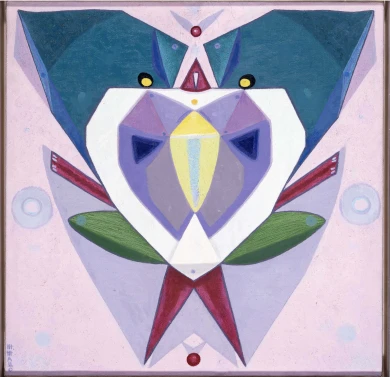
Estrella de Diego Lecture. Holding Your Brain While You Sleep
Wednesday, 3 December 2025 – 7pm
Framed inside the Museo Reina Sofía’s retrospective exhibition devoted to Maruja Mallo, this lecture delivered by Estrella de Diego draws attention to the impact of the artist’s return to Spain after her three-decade exile in Latin America.
Committed to values of progress and renewal in the Second Republic, Mallo was forced into exile to Argentina with the outbreak of the Civil War and would not go back to Spain to settle definitively until 1965 — a return that was, ultimately, a second exile.
Mallo saw out her prolific artistic trajectory with two impactful series: Moradores del vacío (Dwellers of the Void, 1968–1980) and Viajeros del éter (Ether Travelers, 1982), entering her most esoteric period in which she drew inspiration from her “levitational experiences” of crossing the Andes and sailing the Pacific. Her travels, both real and imaginary, became encounters with superhuman dimensions.
In parallel, her public persona gained traction as she became a popular figure and a key representative of the Generation of ‘27 — the other members of which also started returning to Spain.
This lecture is part of the Art and Exile series, which seeks to explore in greater depth one of the defining aspects of Maruja Mallo’s life and work: her experience of exile. An experience which for Mallo was twofold: the time she spent in the Americas and her complex return to Spain.
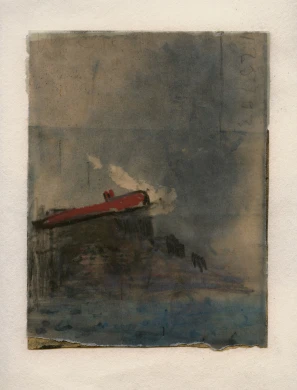
Juan Uslé. That Ship on the Mountain
Tuesday, 25 November 2025 – 7pm
Ángel Calvo Ulloa, curator of the exhibition Juan Uslé. That Ship on the Mountain, engages in conversation with artist Juan Uslé (Santander, 1954) in the Museo’s Auditorium 400 to explore in greater depth the exhibition discourse of this anthological show spanning four decades of Uslé’s artistic career.
The show casts light on the close relationship Uslé’s work bears to his life experiences, establishing connections between different stages and series which could ostensibly seem distant. Framed in this context, the conversation looks to explore the artist’s personal and professional journey: his memories, experiences of New York, his creative process, conception of painting, and ties with photography and film, and the cohesiveness and versatility that characterise his art. Key aspects for a more in-depth understanding of his artistic sphere.
The conversation, moreover, spotlights the preparatory research process that has given rise to this exhibition to grant a better understanding of the curatorial criteria and decisions that have guided its development.
These inaugural conversations, part of the main working strands of the Museo’s Public Programmes Area, aim to explore in greater depth the exhibition narratives of the shows organised by the Museo from the perspective of artists, curators and specialists.



![Miguel Brieva, ilustración de la novela infantil Manuela y los Cakirukos (Reservoir Books, 2022) [izquierda] y Cibeles no conduzcas, 2023 [derecha]. Cortesía del artista](https://recursos.museoreinasofia.es/styles/small_landscape/public/Actividades/ecologias_del_deseo_utopico.jpg.webp)
![Ángel Alonso, Charbon [Carbón], 1964. Museo Reina Sofía](https://recursos.museoreinasofia.es/styles/small_landscape/public/Actividades/perspectivas_ecoambientales.jpg.webp)